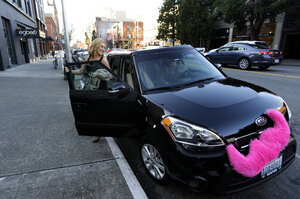Are you an independent contractor? Probably not, Labor Department says.
The Labor Department released detailed guidelines this week for determining whether businesses should designate their workers as "employees" or "independent contractors," and suggested that the latter classification has been used a bit to liberally as companies re-organize and streamline costs.

Katie Baranyuk gets out of a car driven by Dara Jenkins, a driver for the ride-sharing service Lyft, after getting a ride to downtown Seattle. The Labor Department on Wednesday, July 15, 2015 issued new guidance intended to help companies answer whether a worker is an employee or a contractor. The issue has taken on greater urgency with the growth of sharing-economy firms such as Lyft, Uber and TaskRabbit, which increasingly rely on independent workers, often for short-term projects.
Ted S. Warren/AP/File
What it means to have a “job” in the US is becoming harder and harder to pin down these days, and the rise of app-based startups like Uber and TaskRabbit in recent years, as well as increasingly flexible arrangements between firms and staffers, have raised what has become a multi-billion dollar question: When is an employee an employee?
The US Labor Department set out to clarify some of the murkiness around the issue this week, offering up detailed guidance for determining whether businesses should be designating workers “employees” or “independent contractors.” The 15-page document outlines past court judgments that have set precedents for determining the difference, and offers up scenarios in which workers in similar jobs, from nurses to cake decorators might qualify as one or the other.
That depends on a wide range of factors, including how economically dependent on each other the worker and the business are, how much freedom a worker has to set up multiple working relationships, and whether or not the worker’s skills are “integral” to the company’s business model. One example: a book editor who has worked for one publishing house for several years, and edits books based on a company standard, is an employee; an editor who works for several different publishers and negotiates fees based on each job is considered an independent contractor.
Furthermore, the Labor Department suggests that the “independent contractor” distinction has been applied a bit too liberally as companies have downsized and restructured. In fact, it concludes that “most workers” are employees under the Fair Labor Standards Act.
“Misclassification of employees as independent contractors is found in an increasing number of workplaces in the United States,” the agency’s memo reads. When this happens, it says, “employees may not receive important workplace protections such as the minimum wage, overtime compensation, unemployment insurance, and workers’ compensation, Misclassification also results in lower tax revenues for the government and an uneven playing field for employers who properly classify their workers.”
For Uber and its sharing economy counterparts, the debate is more than mere existential quandary. Uber, lauded by investors for its nimble, low-cost business model and quick growth potential, officially employs just under 1,000 full time workers at its San Francisco headquarters. But those selling points will be in serious jeopardy if it is required to consider its 167,000 drivers employees as well. The legal debate over an Uber driver’s employment is far from settled: Lower courts in Florida and California have ruled individual drivers employees, but Uber is fighting the ruling. Meanwhile, complaints suits have been filed against several companies with similar operating models, including Washio, a dry cleaning delivery company, and Postmates, a courier service.
But the implications go far beyond the sharing economy. As the Labor Department notes, contract work has become widespread in a large number of industries, including construction, auto-retailing, and maintenance, to name a few. Companies outsourcing ancillary jobs, like payroll services and janitorial work, is now commonplace. An estimated 1 in 3 US workers are now considered freelancers, and the number of “non-employer” businesses, or companies without any other full-time staff, has grown by about 4 million in the past decade, according to the Census Department.
The Labor Department cautions that the memo is by no means a directive, and that courts can cite it in labor disputes but are not bound by it. Still, business organizations, including lobbies for the construction industry and small business owners, decried the guidelines. The International Franchise Association, which represents the interests of location owners for chains like McDonald’s, called it “unnecessarily intrusive” and “yet another in a long list of Obama Administration directives that will make it harder for millions of small businesses to operate and grow.”

